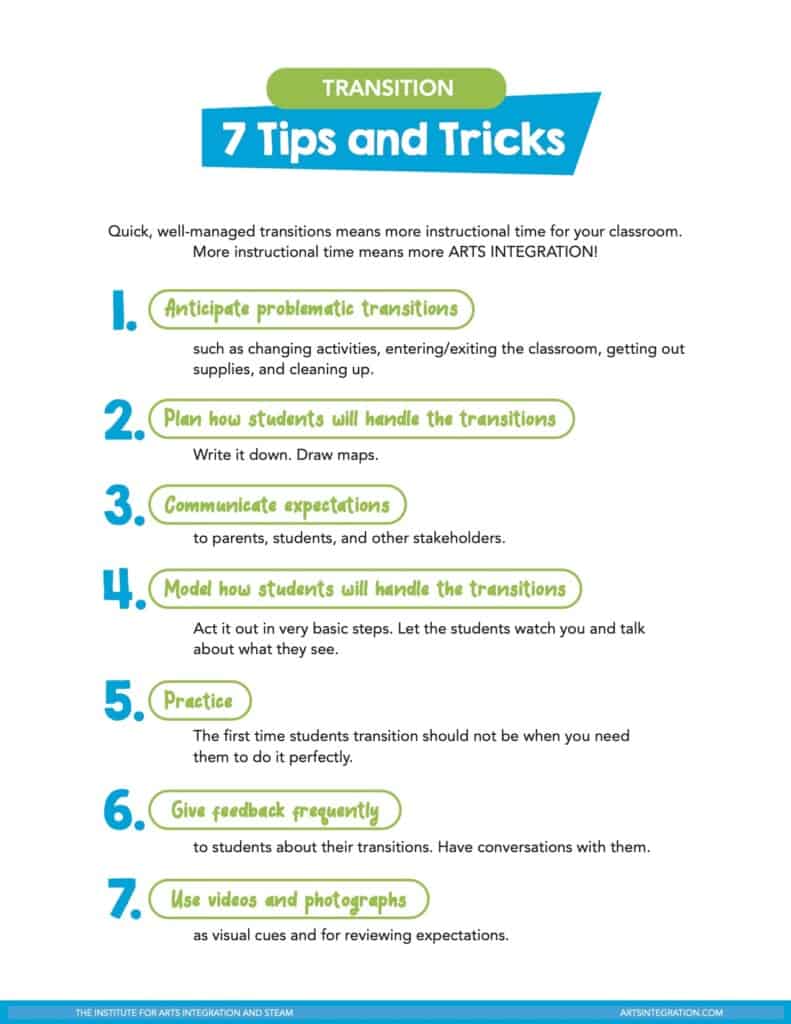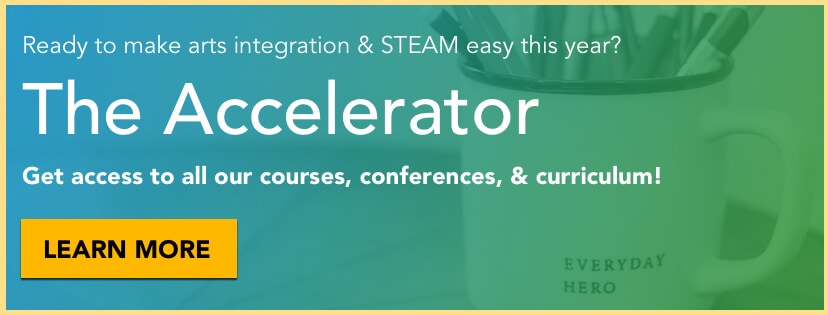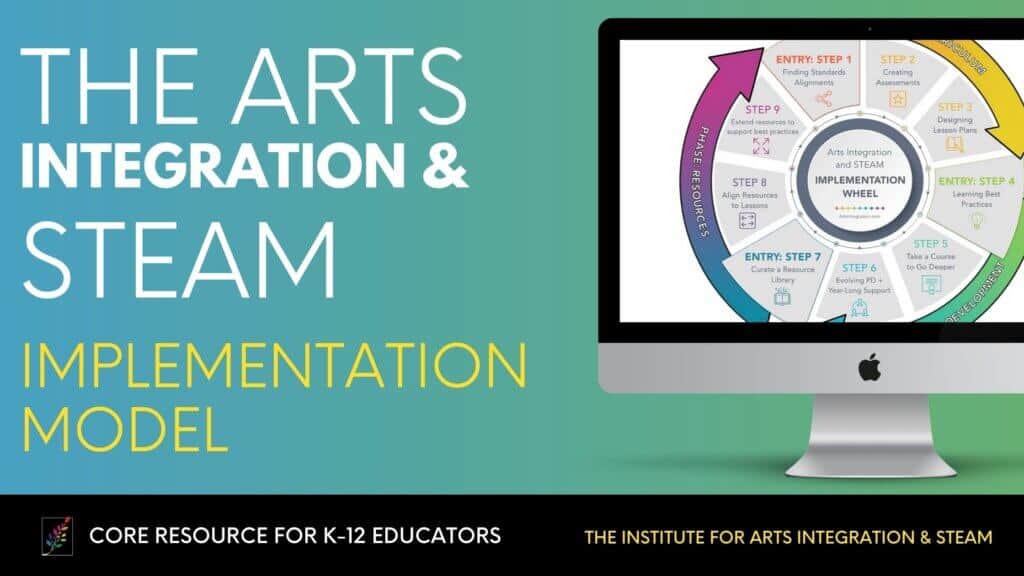Talk to any educator and they have a classroom management plan. Even if they don’t have a specific set of strategies and are just winging it – that’s their plan.
But now, more than ever before, having a strategic classroom management plan that continually works for you is imperative. Since the pandemic, more educators are reporting students who lack basic social skills and the ability to follow directions. Classroom management frustrations are being cited as some of the top reasons many educators are considering leaving the field.
If you’re struggling with classroom management, you’re not alone. It doesn’t make you a poor teacher, nor does it reflect upon you personally. Classroom management is a skill that can be taught and learned, just like the content you share with your own students.
This guide is a collection of strategies, tools, and supports that master educators in our community have shared. Use these ideas to build your own classroom management plan which reflects your teaching style and goals for your students.
Reframe your Classroom Management Definition
It’s important to acknowledge that classroom management is not synonymous with punishment or discipline. In fact, classroom management is the opposite of punishment.
Instead, classroom management focuses on setting your students and yourself up for success during your time with them. It is not meant to be punitive in nature, but instead to feed the basic human need for having clear expectations and a way to achieve those expectations.
Positive classroom management reflects teachers who build relationships with their students, establish clear expectations, provide structure and guidance and have a set of corresponding rewards or consequences for the aligned behaviors.
When you have an established classroom management plan, you are actually able to provide students with MORE freedom, not less, because they understand where the boundaries are located. You are sharing a framework and giving students the ability to move within that framework creatively and collaboratively.
Once you have your classroom management plan in place, you will be able to have more time for: centers, groupwork, independent study, choice and hands-on projects. These are not possible, however, without the time and care to develop and establish your classroom management plan with your students.
Building Your Plan
There are three key components every classroom management plan needs from the beginning: setting the tone, designing the structure, and creating a written plan. Think of these as the foundational blocks of classroom management. Each is intentionally designed to encourage students and provide boundaries within your instructional setting.
Keeping it Positive
One of the very best things you can do is to remain calm and stay positive in your classroom, no matter what happens. This is MUCH more difficult than it sounds. When you have students who are playing with rulers or banging on instruments after you have told them not to twenty times before, it’s hard to stay positive. But you have to, because they are testing you – and the minute you turn negative, that’s the minute you fail their test.
Starting the class with a positive attitude is a critical strategy for classroom management. Not that fake, syrupy positivity; but a genuine happiness that these students are with you at that moment. It lets students know you care about them as people. Every human being wants to know someone cares about them. So approaching your classroom with this mindset can immediately set you up for a better day.
Here’s a few ways to encourage positive energy right from the start of class:
- Greet your students at the door – every single class. This clues you into their mood and creates a personal connection.
- Point out positive behavior, rather than negative. Students are looking for attention. If you only give attention to positive behaviors, the negatives will be less tempting to try. Try this: “I like the way that….”
- End the lesson with something they did that you enjoyed – no matter what. Even if the whole class felt like it went awry, find something that your students did that was positive. This will leave them with the knowledge that you are seeking out ways to build them up, not tear them down.
Step Up the Structure
We all thrive on structure – whether we like to admit it or not. How you structure the way your classroom looks, the way you approach instructional delivery, and the way your students can use materials is all a part of a smooth classroom management plan. Structure doesn’t always equal “neat and organized” but it does always equal a productive classroom.
Creating an environment where students know where materials go before, during and after a lesson is critical. Empower your students to take responsibility for these items by establishing clearly how your space is set up at the very beginning of your time with them.
Additionally, establishing routines is an important aspect of the structure of your class. This can include everything from the way your students walk in, to where they sit, the jobs each student has, and how to transition between activities. Create a series of routines for the top 4-5 activities and stick with them – consistency is key.
Here are 3 quick strategies to establish structure in your classroom:
- Create dedicated sections in your space. Humans thrive on knowing where things are located and having organization. Make sure your students know where materials are located, as well as what areas of the space are dedicated to specific purposes.
- Go easy on the amount of visuals in your space. Classrooms that contain visuals everywhere can be hyperstimulating for students. Instead, it’s better to create selective visuals that are high-impact and purposeful to specific tasks or information.
- Set up a routine and stick with it. Every teacher has their own unique routine sequence that works for them. Pick one that truly reflects you and then stick with it. Use the routines each and every class so that your students know what to expect. Additionally, as you introduce new materials or transitions, establish and maintain those routines as well.
Create a Written Plan
The educators with the best classroom management are always the ones who plan for classroom management. Creating a written classroom management plan is one of the best time investments you can make.
First, you’ll have a support document if your administrator wants to know what your policies and procedures are or ever has any questions. Second, and more important, is that you will have the peace of mind that comes with having an action plan put into place that is both clear and sequential in its use.
This doesn’t need to be an overwhelming document. Don’t go writing 40 pages about each and every step in your classroom management process. Instead, create a sheet like the example below to outline the purpose of classroom management in your space and how you plan to execute it with integrity and consistency.

Procedures that Work
Developing routines and procedures is monumentally helpful when it comes to your classroom management plan. These are separate to strategies, which can be a part of procedures, but are not routines in and of themselves.
Procedures provide students with a sense of calm: they know exactly what to expect and what is expected of them. To help remind students of these procedures, having visuals in place that show the routine expected as well as text that describes it is often helpful. Memes are great for this, as are images of students modeling the routine.
Additionally, it’s incredibly important to be consistent in your implementation. You can’t have a different set of expectations for each class. Develop procedures that are followed across the board. And whenever possible, model through actions, rather than words.
Let’s dive deeper into specific procedures and routines that can help support your classroom structure.
Managing Transitions
Don’t let classroom transitional times cause you and your students trouble. Follow these five steps to ensure smoother, more efficient transitions in the classroom:
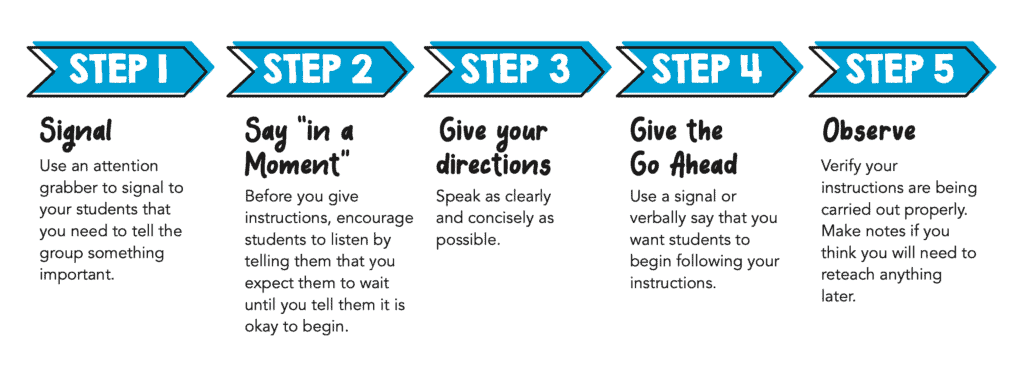
- Signal. Use an attention grabber to signal to your students that you need to tell the group something important.
- Say “In a Moment…” Before you give instructions, encourage students to listen by telling them that you expect them to wait until you tell them it is okay to begin.
- Give your directions. Speak as clearly and concisely as possible.
- Give the Go-Ahead. Use a signal or verbally say that you want students to begin following your instructions.
- Observe. Verify your instructions are being carried out properly. Make notes if you think you will need to reteach anything later.
Once you’ve established this routine for transitions, it’s time to monitor and adjust as necessary. If you find that transitions are still difficult for your students, try these 7 tips from arts integration specialist Amanda Koonlaba:
Managing Organization
Classroom organization really falls into 3 categories: the classroom itself, classroom supplies, and student organization.
When organizing your classroom, be sure to look for consistent colors, themes, fonts, and clarity. It’s so easy to go overboard with visuals and classroom setup. But simple is always better than cluttered.
Try to create dedicated spaces in your classroom for specific tasks. For example, create a space where students look for anchor charts or definitions. Or, have a dedicated area where students can find books for silent reading.
This sounds simple – and it is. But it can be just as easy to randomly grab whatever area is available to pull small groups for instruction. If you have a dedicated space where students always go for specific tasks, it makes your classroom management plan so much easier to implement.
When helping students get organized, there are 3 foolproof tips that work for almost anyone:
- Declutter. Give students time to clean out there backpacks, desks, binders and other areas where individual items are stored. Recycle, remove and reorganize!
- Make Checklists. Set up clear expectations by creating checklists. Help students create their own to-do lists. Show students how to prioritize tasks.
- Label and Color Code. Help students color code materials by subject or time of the day that items will be needed. Let students put labels on personal items.
Finally, when organizing materials for your classroom, here are 9 tips and tricks that can streamline your process:
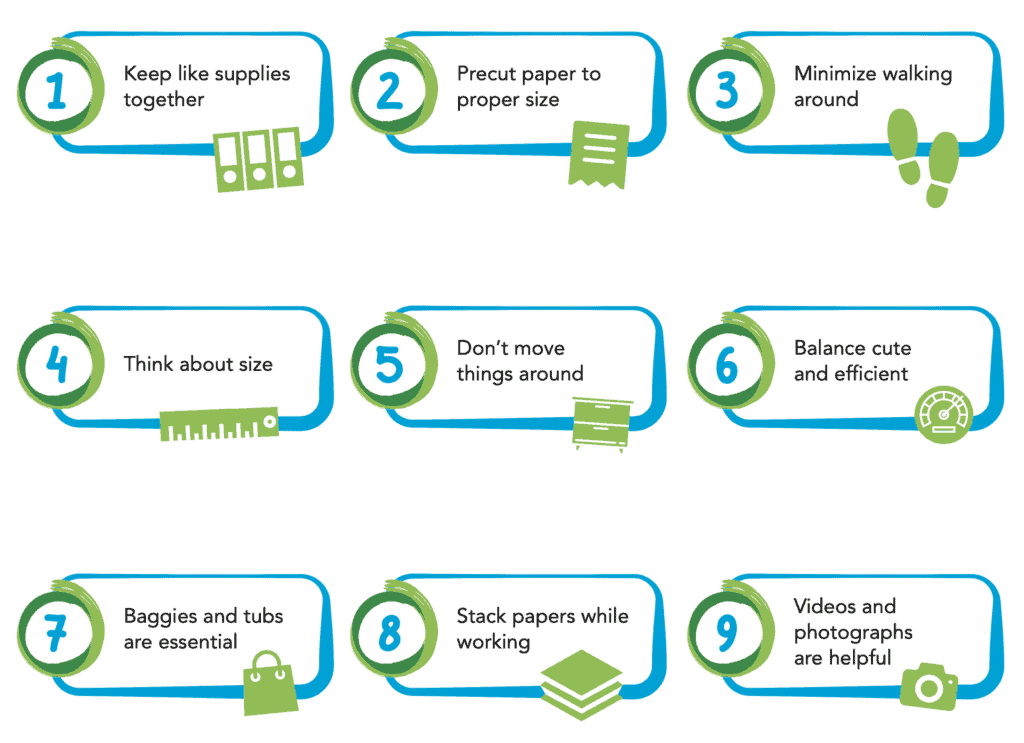
Developing Respect
As educators, we want our students to respect us, our class, and our content. As is so often said, respect is earned and this is a two-way street. Developing a relationship with students will go a long way towards building a respectful environment. Here’s a few pointers to foster respect between you and your students:
1. Reward ONLY students modeling desired behaviors.
Remember that to your students, rewards can come in many different forms: attention, getting you flustered, or in an extrinsic incentive. Be sure that you only acknowledge those students who are using the behaviors you expect. Those students who are challenging your expectations should not receive your attention. Instead, when they are finished, calmly refer them to the consequence earned by their action and move on. Respect given = respect earned.
2. Get to know your students.
Say hello to them outside of your classroom and engage them in a conversation. Everyone wants to feel valued and this is the foundation to respect. Never point out a student’s struggle or misbehavior and never pull them aside in front of the group. It all comes down to the golden rule: treat others as you would like to be treated.
3. Use the Power of Proximity.
Even though challenging behavior can make us want to stop everything and address it directly, it’s often a better idea to keep going with your activity. Rather than stopping the lesson to speak with the student, try moving closer to that student or continuing to teach while moving that child to another area of the space. Your presence alone may be enough to redirect the student.
4. Treat all students equitably, not equally.
Students are not all the same. What strategies work with one student may not work with another one. The key is to approach your classroom management plan with equity: giving each student what they need to be successful. This is different than equal treatment, where everyone receives the same strategies. This is also a great lesson for our students to learn when working with others, so by modeling this behavior, we are teaching them valuable interaction skills.
Classroom Management Strategies
Classroom management is not a one- size-fits-all approach. Yet, many times we see teachers who are trying to use the same strategies in high school that they used in elementary or middle school.
Indeed, some strategies will translate to all grades, but others will not. Our job is to be able to discern ideas that will work for our areas and our grade levels.
Once you find strategies that work for you, leverage them. Don’t try something new just for the sake of something new. In my elementary classroom, my classroom management plan included literally one (sometimes two) strategies and that’s it. It wasn’t flashy, but it worked.
If you are stuck or need a boost in classroom management ideas, I encourage you to look through this list and try just one new tip. If it works, keep it. If not, keep trying!
Teaching Expected Behaviors
This could and should be used at any grade level. It’s not enough to just talk about behaviors – we have to intentionally teach them, practice them, and keep spiraling through them, just like our curriculum.
First, be clear about what you want and what you do not want. Ambiguity is the enemy of effective classroom management. Shine a light on every expected behavior and then show students the incorrect way of doing things. Make sure they understand what you want to see and what constitutes misbehavior.
Second, communicate the importance of expected behaviors by using photographs, posters, and signs to show what you have clearly articulated.
Third, dominate appropriately and be assertive. Dominance is your ability to provide clear purpose and strong guidance regarding both academics and student behavior. It is your classroom, you are in charge. When you’re assertive, your students will see:
- Your Body Language: stand up straight and keep enough distance to not appear threatening.
- Your Expression: look your students in the face when speaking to them and match your facial expression to your message.
- Your Tone of Voice: this needs to match the situation. It’s not conversational when giving a command, but it is respectful and show emotions when appropriate to the message.
Finally, give feedback and practice. Feedback should be immediate, varied, and meaningful. When you see students doing an expected behavior, immediately share with them how pleased you are to see it. When students are not behaving as expected, swiftly address the issue in a respectful manner.
Practice is extremely important in teaching expected behaviors. We don’t teach a math concept and immediately expect our students to be masters of it. So why would we expect teaching behaviors to be different? Here’s some times to practice behaviors:
- First Week: Give the information and practice every single day for at least an hour.
- First Month: Review every single day – use your judgment for how long
- After Holidays: Review when you return – use your judgment for how long
- Other: Stop and reteach or review when you see a need
Teaching Mini-Lessons
Mini-lessons can be an excellent strategy for students to learn a skill when they have trouble focusing or need constant redirection to stay on task.
Mini-lessons can quickly integrate an arts area with a small chunk of the core lesson you’re teaching. They can be used in whole group, small group, or even individual instruction. But the best part about mini-lessons is that they are short. Mini-lessons give you just 5-10 minutes to teach a concept or skill and let students explore it through an art form.
This keeps students engaged, while working through key concepts. Here’s some examples of both E/LA and Math mini-lessons you may want to try:
E/LA Mini-Lessons:
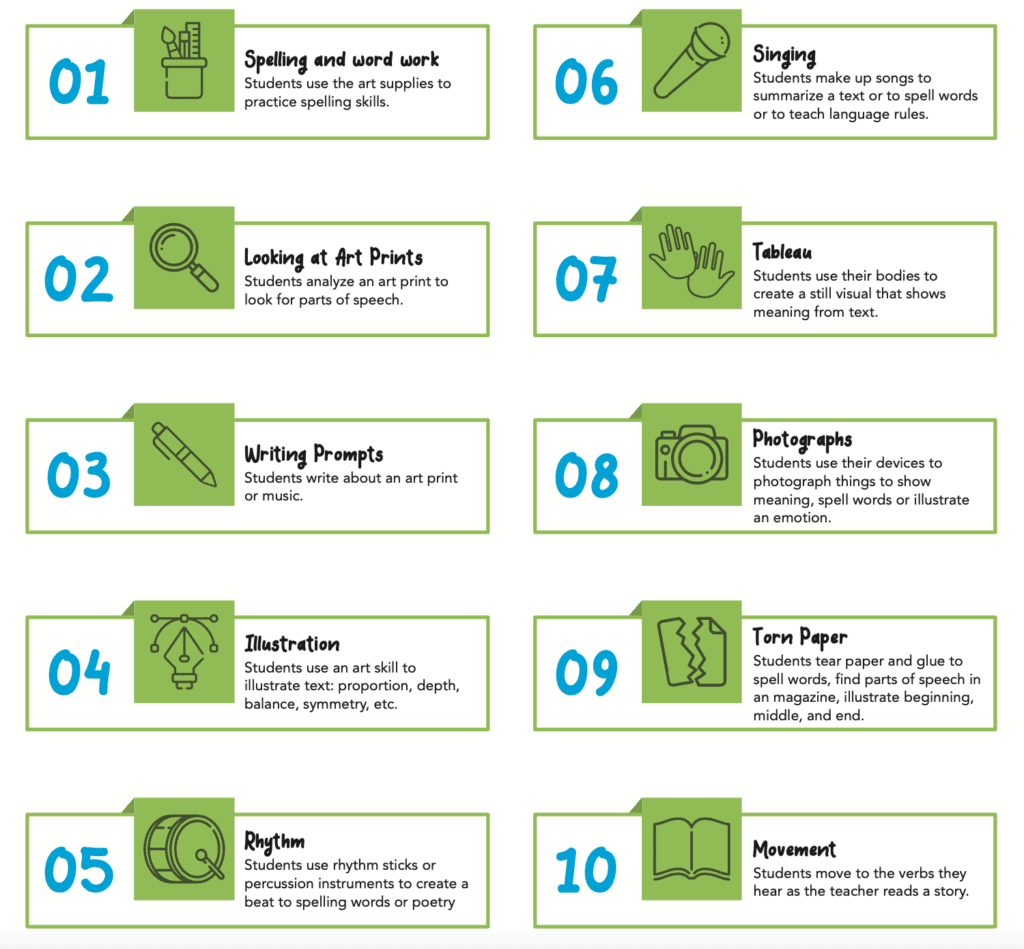
Math Mini-Lessons:

Small Group Instruction
Small group instruction allows you time with a set of 2-6 students at a time. This allows you to better understand the specific skills each student has surrounding a topic. Here’s some methods and considerations for grouping students in these settings:
- Random: Chosen without method or conscious decision. Used when trying to ensure equal size groups.
- Cooperative: Chosen to allow the assignment of “jobs” for each student. Used when students need to work on specific social skills.
- Ability: Chosen according to ability. Used when students have similar academic needs.
- Interest: Chosen by student interest in a subject or topic. Used when similar interests will enhance overall learning.
- Student Choice: Students group themselves however they wish. Used when social interaction and engagement are needed.
- Expertise: Chosen according to the particular expertise of students. Used when students benefit from knowledge of peers.
Whole Group Instruction
Whole group instruction is appropriate when there is a large amount of information that needs to be presented quickly, as an overview, or to share basic information. Here are 4 ways to use whole groups:
- Lecture: Verbal imparting of knowledge.
- Discussion: Focused on student interactions sharing about a topic.
- Debates: Based on controversial issues – issues that have pros and cons.
- Demonstrates: Showing a step-by-step method
Elementary Classroom Management Strategies
Many of these may be familiar to you, but we list them here because we continue to see them work!
Adapt School System
If your school has a system they use, try to adapt it to your needs. For instance, many schools use the traffic light – green, yellow (warning), red (time out). Try using this with an entire class instead of individual students. Use an art pallet or music staff for more personalization in the fine arts classroom.
Hand Signals
Interruptions can be tough when you have limited time. Try establishing a set of hand signals students can use for specific situations (like asking to go to the bathroom).
Attention Getters
Try using a rhythmic clap or a call and response phrase for attention, such as “We are ready…bum, bum-bum-bum, bum-bum-bum” (tune of Farmer’s Insurance commercial).
Class Competition
This one strategy has helped transform many of our teachers’ management plans. It’s so simple! Each class competes with the teacher (see the t-chart below). Whenever the students demonstrate a desired behavior, select a student to put a tally mark on their side of the chart. If the teacher notices challenging behaviors, you receive a tally mark on your side as the teacher. At the end of the class, if the class has more points than the teacher, they get a check for their class. When the class receives 5 checks, they win a “game” day – a lesson that is taught in game format.

Middle School Classroom Management Strategies
Middle school students want to feel independent and empowered. Anytime you can utilize strategies that fill this need, you are creating an environment where students will want to learn and be engaged.
Shift the Power
One of the ways to do this is to shift the responsibility for class set up to the students. Provide them with the opportunity to design aspects of their learning environment: specific centers/stations, perhaps a presentation area for their work, or even how each table will be organized.
This gives them choice over their learning environment and provides you with less “work” of setting up and putting away.
If you are on a cart or if you have different setups for each class, put the students in charge of getting materials out and organizing them upon cleanup. It builds responsibility and an investment into their own class experience.
One last thing: Change up the learning spaces often to keep your students on their toes.
Seat Choice Roles
Give students responsibility for certain jobs/roles depending on their seat choice for that day.
Problem-Solving Station
Do you have early finishers? Students who rush through their work? Try setting up a “problem-solving” station that provides students with an essential question or problem and a variety of materials they can use to solve that problem if they finish early.
Decide Now App
Use the Decide Now app as a reward for excellent CLASS behavior. Have students collaborate on what rewards would be meaningful for them and then plug them into the app. When students earn a reward, you can use the app to randomly pick something they chose as an option.
High School Classroom Management Strategies
At this level, students work to earn the respect and responsibility they feel they deserve. Your classroom management system should reflect specific opportunities for students to demonstrate that reciprocal, respectful relationship.
3-2-1 Strategy
Synthesizing information learned in your classroom doesn’t end with you. Use this strategy as a way to wrap up the lesson and to encourage students to be engaged throughout their time with you. Used consistently, students know that they need to actively participate throughout the lesson to contribute at the end of class.
At the end of class, have students summarize the lesson with 3 things that they learned, 2 things that were interesting from the lesson and 1 question they still have. These can be submitted as an exit ticket, through an online tool like Socrative or as a class discussion.
Poll Students
Get student opinions or check for understanding with apps like Socrative or Poll Everywhere. Can be used with mobile devices or clicker systems.
10:2 Rule
Provide 10 minutes of instruction and then offer 2 minutes for students to process or respond to what you’ve just taught. This encourages much more active participation.
Pick up the Pace
Limit the downtime available in your class. This includes transitions between topics or into groups. Provide a countdown system so that students are moving quickly and transitioning to the next activity.
Classroom Management Tips and Tricks for All Grade Levels
Each of these ideas can be used in any situation and with any grade level. Feel free to adapt these to fit your personal teaching style and student learning preferences.
Lower the Volume
When you find yourself ready to raise your voice above the volume of the room, stop and shift to speaking softly and calmly. The softness is the opposite of what students will expect and will gain their attention much faster.
Pause Your Instruction
Every once in a while, stop mid-instruction and ask students to respond to what you just shared. This breaks up the content and encourages students to be active listeners and contributors to the learning.
Looks-Like, Sounds-Like Chart
Anchor charts help provide the key information visually in small segments. In the “Looks Like, Sounds Like” anchor chart, you can identify positive behaviors you expect and have students describe (or draw/sketch/photograph) what each behavior looks like and sounds like in the classroom.
Use Humor
Humor is a technique that is often overlooked or overused. Students are humans too and we all like to laugh! Embed humor at key times or in visuals (like using #notyourmaid when asking students to clean up) to help provide a release and connect with your students on a human level.
Final Thoughts
Creating a classroom management plan provides you with an opportunity to connect and engage with your students in what may be their only positive experience that day. Just remember:
- Make a plan. You can’t approach classroom management by tossing jello and seeing what sticks. Instead, think through a specific plan for management and write it down.
- Be consistent. Implement your plan step by step and consistently enforce it at every turn for all students.
- Find 1-2 strategies that work. Don’t overcomplicate this – find what works for you and stick with it.


